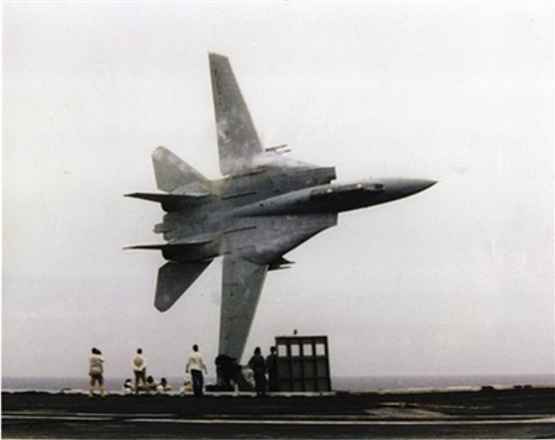ryan1234
Desensitized Member
TomCatter?
Ha - I was actually being serious... and by "here" I meant where I work.. He's a fairly well known guy in the Naval Aviation world.
TomCatter?
A-10 and the TF-34s had same vis-a-vis compressor stalls and being in the engine disturbance zone in nearly the slightest. More than once have guys been doing BFM/ACM and compressor stalled, sometimes unrecoverable and requiring shutdown.
Ha - I was actually being serious... and by "here" I meant where I work.. He's a fairly well known guy in the Naval Aviation world.

Whatever happened to the engine upgrade plans for the A-10?
So, pardon my dim-witedness, but can someone explain why, on a swept wing design (think global or DC10, or B52!; something with an aggressive sweep) if you enter an aggressive, prolonged forward slip (full rudder) that it doesn't create a roll / over-the-top stall towards the trailing wing? In other words, once in the slip, the "forward" wing has an effective sweep of say, 0 degrees, with almost all chord-wise flow while the trailing wing now has an even larger sweep, with a whole lot more span-wise, non-lift-producing flow.
I was taught this was the reason you don't forward slip a swept wing jet and I haven't seen it brought up here. Just wondering if this was bunk reasoning. Where's tgrayson when you need him?
I was sitting in a pilot briefing at my squadron where the Wing pilots were being briefed by the CC of the AFRES/ANG Test Center about new engines for the A-10 being bought, paid for, and ready to install........
.......problem is, this briefing was back in the year 2000.
Just wondering if this was bunk reasoning. Where's tgrayson when you need him?
So, pardon my dim-witedness, but can someone explain why, on a swept wing design (think global or DC10, or B52!; something with an aggressive sweep) if you enter an aggressive, prolonged forward slip (full rudder) that it doesn't create a roll / over-the-top stall towards the trailing wing? In other words, once in the slip, the "forward" wing has an effective sweep of say, 0 degrees, with almost all chord-wise flow while the trailing wing now has an even larger sweep, with a whole lot more span-wise, non-lift-producing flow.
I was taught this was the reason you don't forward slip a swept wing jet and I haven't seen it brought up here. Just wondering if this was bunk reasoning. Where's tgrayson when you need him?
Tgray is around, just not on here lately.
As for the reasoning, while what you said is true, my response would be "so what?". How would that be an issue at all?
Seagull's post is backed up 100% by the applicable manuals. You would need opposite aileron in order to counteract the roll tendency from the upwind wing, but it's not a big deal as long as you're ready for it. Speaking for the 757 and 767, that rolling moment is benign and easily controlled without roll spoilers.
Just seems like with the C upgrade, it only makes sense to upgrade the Engines as well... so many advantages long term.
Yeah, it makes sense now. Thanks! It was one of those things that an instructor taught me long ago and it stuck before I really thought critically about it and years later it seemed like gospel; IF YOU SLIP WITH A SWEPT WING IT WILL STALL AND SPIN!! When in reality the effect is much less exaggerated and the application of aileron balances it out.
Somewhat, but not really. We've built our tactics around what we have. The new engines proposed were somewhat heavier, yet with negligible thrust benefit. Making the aircraft heavier won't necessarily help. What the fleet has, works, albeit with long-known limitations that have for the most part been accounted for.
The flat-rated TF34-GE-101 doubles the hot day thrust output over current engines, eliminating take-off gross weight limitations that preclude today's A-10 from delivering its most powerful mission punch. Other -101 performance advantages include:
By leveraging a $400-million GE investment for commercial engine development and a solid production base, the TF34-GE-101 can be procured on an affordable Commercial Off-The-Shelf (COTS) basis.
- A significant reduction in takeoff distances during hot day conditions.
- Improved high altitude performance.
- 30% more acceleration capability and a 2X turn rate for improved maneuverability.
- An approximate 3X time-to-climb improvement at full combat weight.
- CONUS to European deployment in one-third the time - without tying up tanker assets and valuable manpower.
- A positive "single engine rate of climb" safety margin at maximum gross takeoff weight.
Maintenance costs (including spares, labor and overhaul) are projected to be less than one-fourth the cost of maintaining current engines. Coupled with a lower maximum thrust rating for robust, reliable operation, significant savings can be realized over the remaining life of the A-10 fleet.
A true force multiplier, the A-10 with TF34-GE-101 engines can offload the F-16 Block 40/50 aircraft from close-air support missions and free these valuable assets to perform other critical tasks
enchilada
Kind of like that Christmas present thats just too far out of the realm of reality.
F-35?
takeoff distances
high altitude performance
acceleration capability
time to climb
deployment time
single engine rate of climb
Hey, I see what you guys are doing there!
The A-10 isn't a swept wing, transport category jet!
